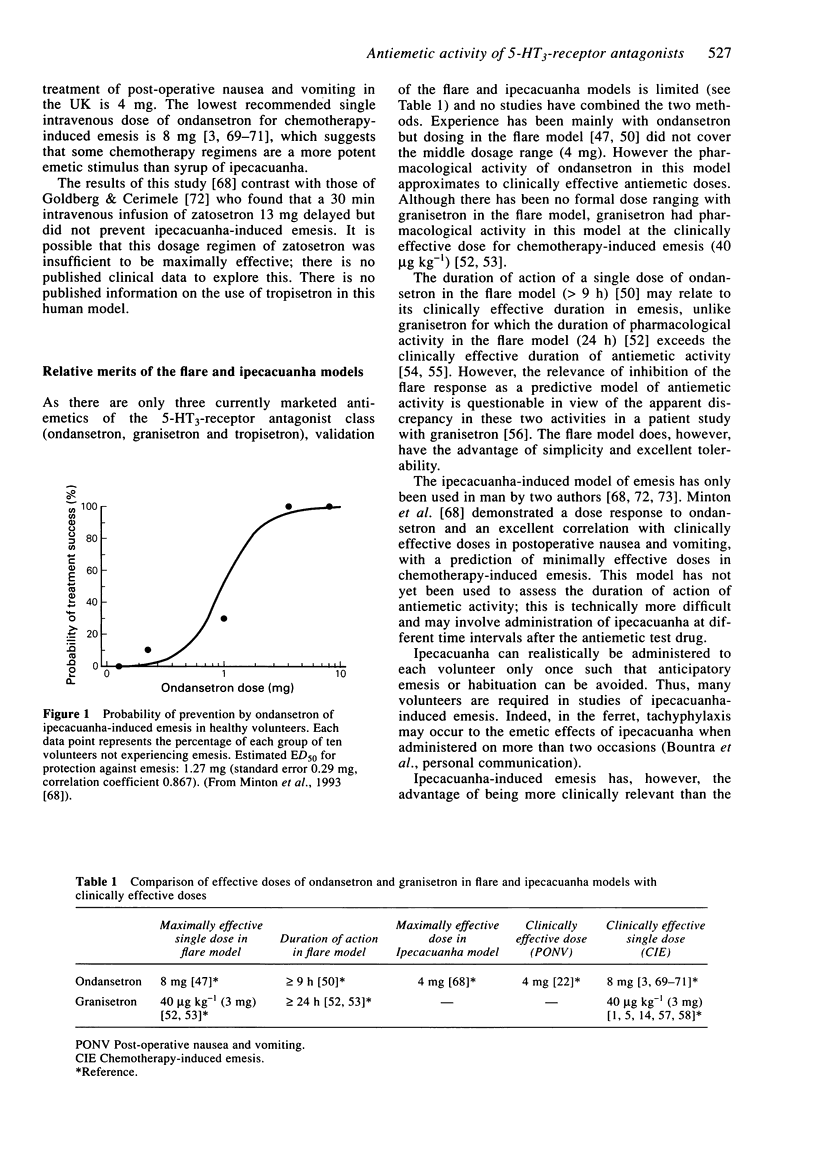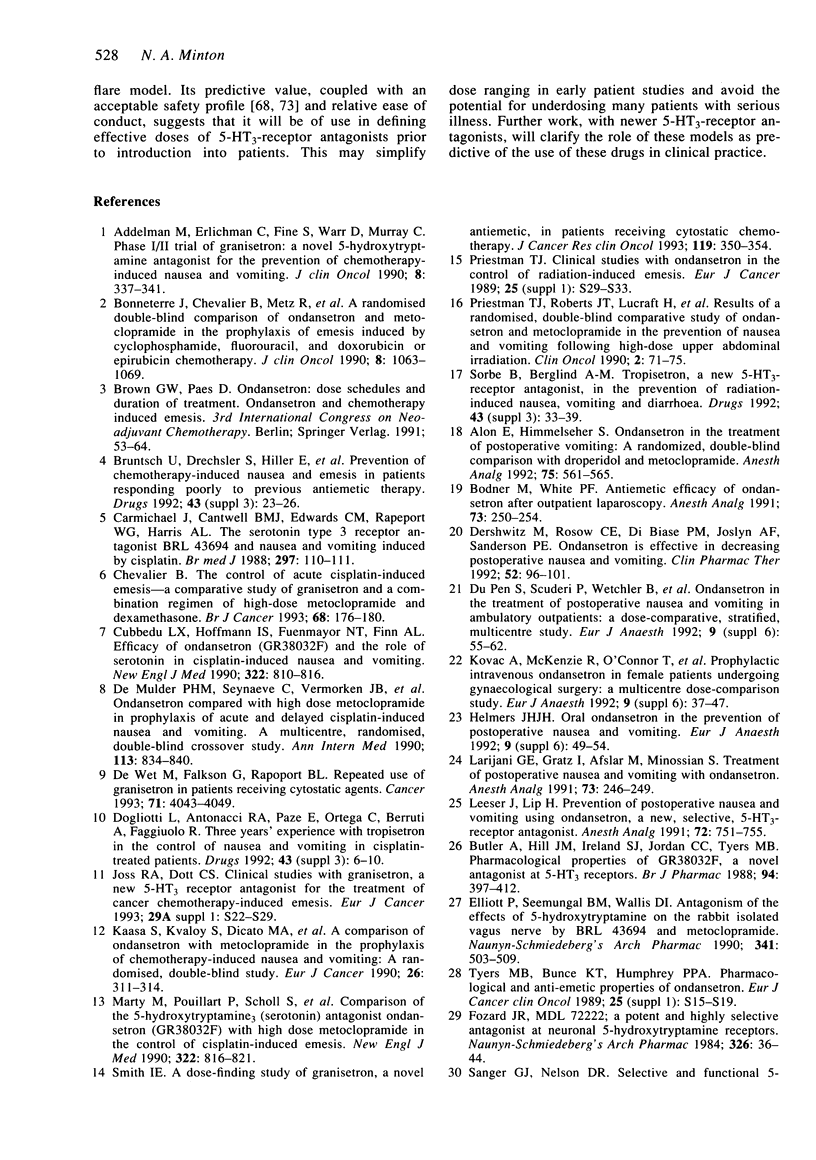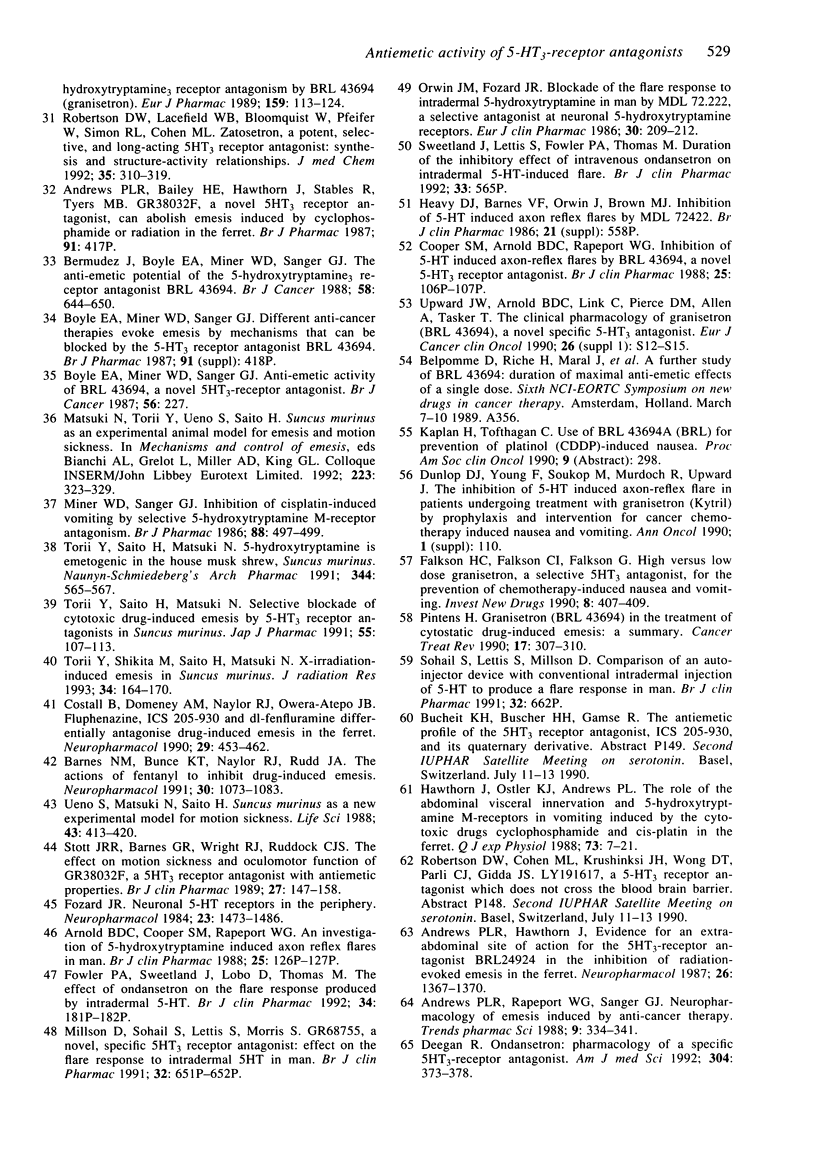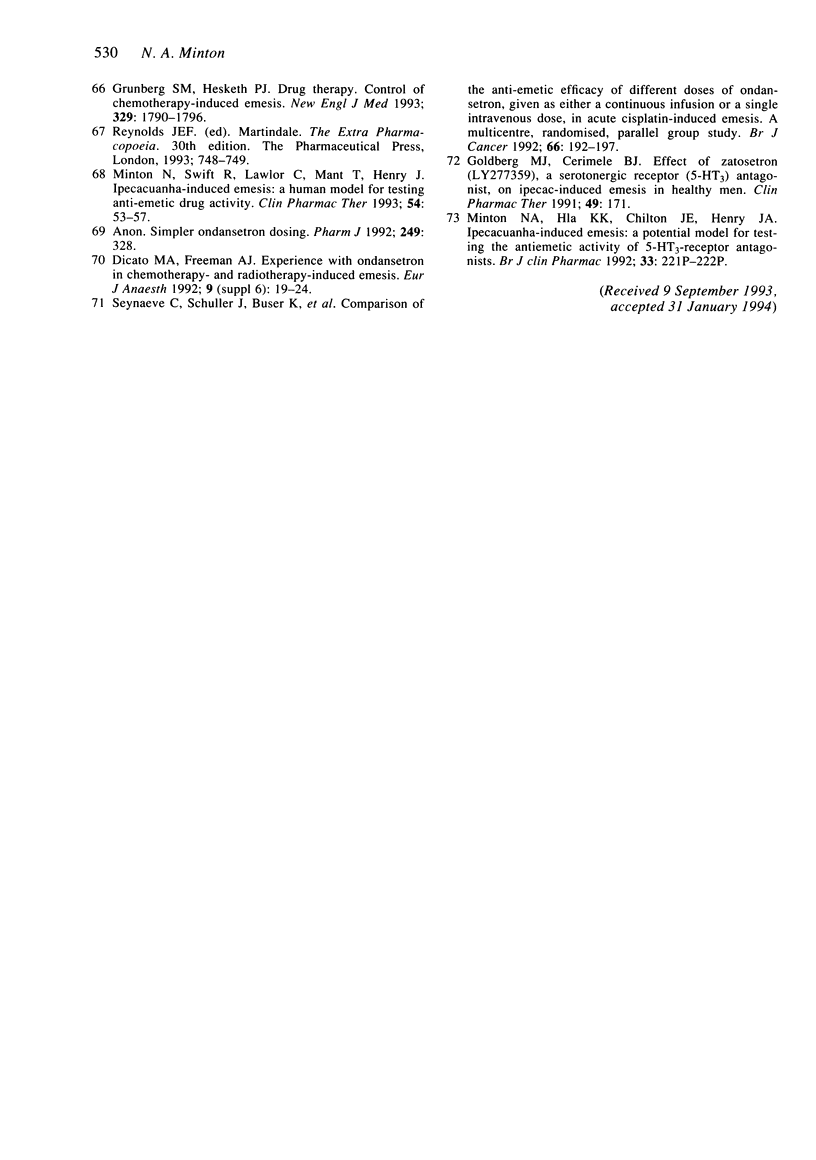Abstract
1. Selective 5-HT3-receptor antagonists are highly effective in preventing nausea and vomiting associated with chemotherapy, radiotherapy and surgery. Their pharmacological activity may be determined in vitro and in animal models of emesis. However, these methods may not give an accurate indication of the antiemetic dose range of 5-HT3-receptor antagonists in patients. Two volunteer models have been used to predict more accurately clinically effective antiemetic doses of 5-HT3-receptor antagonists. 2. The flare response to intradermal 5-HT is thought to be mediated by excitation of 5-HT3-receptors on cutaneous afferents, with release of substance P and subsequent vasodilation. Antagonism of the flare response appears to provide an indication of the effective antiemetic dose of 5-HT3-receptor antagonists but data on duration of action are conflicting. 3. Ipecacuanha-induced emesis is thought to be mediated through both peripheral and central 5-HT3-receptors. Antagonism of this response has demonstrated a close correlation with clinically effective antiemetic doses of the specific 5-HT3-receptor antagonist, ondansetron, and has the advantage of being more conceptually relevant than the flare model. 4. Further work, with newer 5-HT3-receptor antagonists, will clarify the role of these models as predictive of the use of these drugs in clinical practice.
Full text
PDF





Selected References
These references are in PubMed. This may not be the complete list of references from this article.
- Addelman M., Erlichman C., Fine S., Warr D., Murray C. Phase I/II trial of granisetron: a novel 5-hydroxytryptamine antagonist for the prevention of chemotherapy-induced nausea and vomiting. J Clin Oncol. 1990 Feb;8(2):337–341. doi: 10.1200/JCO.1990.8.2.337. [DOI] [PubMed] [Google Scholar]
- Alon E., Himmelseher S. Ondansetron in the treatment of postoperative vomiting: a randomized, double-blind comparison with droperidol and metoclopramide. Anesth Analg. 1992 Oct;75(4):561–565. doi: 10.1213/00000539-199210000-00017. [DOI] [PubMed] [Google Scholar]
- Andrews P. L., Hawthorn J. Evidence for an extra-abdominal site of action for the 5-HT3 receptor antagonist BRL24924 in the inhibition of radiation-evoked emesis in the ferret. Neuropharmacology. 1987 Sep;26(9):1367–1370. doi: 10.1016/0028-3908(87)90100-6. [DOI] [PubMed] [Google Scholar]
- Andrews P. L., Rapeport W. G., Sanger G. J. Neuropharmacology of emesis induced by anti-cancer therapy. Trends Pharmacol Sci. 1988 Sep;9(9):334–341. doi: 10.1016/0165-6147(88)90106-x. [DOI] [PubMed] [Google Scholar]
- Barnes N. M., Bunce K. T., Naylor R. J., Rudd J. A. The actions of fentanyl to inhibit drug-induced emesis. Neuropharmacology. 1991 Oct;30(10):1073–1083. doi: 10.1016/0028-3908(91)90136-y. [DOI] [PubMed] [Google Scholar]
- Bermudez J., Boyle E. A., Miner W. D., Sanger G. J. The anti-emetic potential of the 5-hydroxytryptamine3 receptor antagonist BRL 43694. Br J Cancer. 1988 Nov;58(5):644–650. doi: 10.1038/bjc.1988.277. [DOI] [PMC free article] [PubMed] [Google Scholar]
- Bodner M., White P. F. Antiemetic efficacy of ondansetron after outpatient laparoscopy. Anesth Analg. 1991 Sep;73(3):250–254. doi: 10.1213/00000539-199109000-00003. [DOI] [PubMed] [Google Scholar]
- Bonneterre J., Chevallier B., Metz R., Fargeot P., Pujade-Lauraine E., Spielmann M., Tubiana-Hulin M., Paes D., Bons J. A randomized double-blind comparison of ondansetron and metoclopramide in the prophylaxis of emesis induced by cyclophosphamide, fluorouracil, and doxorubicin or epirubicin chemotherapy. J Clin Oncol. 1990 Jun;8(6):1063–1069. doi: 10.1200/JCO.1990.8.6.1063. [DOI] [PubMed] [Google Scholar]
- Bruntsch U., Drechsler S., Hiller E., Eiermann W., Tulusan A. H., Bühner M., Hartenstein R., Koenig H. J., Gallmeier W. M. Prevention of chemotherapy-induced nausea and emesis in patients responding poorly to previous antiemetic therapy. Comparing tropisetron with optimised standard antiemetic therapy. Drugs. 1992;43 (Suppl 3):23–26. doi: 10.2165/00003495-199200433-00006. [DOI] [PubMed] [Google Scholar]
- Butler A., Hill J. M., Ireland S. J., Jordan C. C., Tyers M. B. Pharmacological properties of GR38032F, a novel antagonist at 5-HT3 receptors. Br J Pharmacol. 1988 Jun;94(2):397–412. doi: 10.1111/j.1476-5381.1988.tb11542.x. [DOI] [PMC free article] [PubMed] [Google Scholar]
- Carmichael J., Cantwell B. M., Edwards C. M., Rapeport W. G., Harris A. L. The serotonin type 3 receptor antagonist BRL 43694 and nausea and vomiting induced by cisplatin. BMJ. 1988 Jul 9;297(6641):110–111. doi: 10.1136/bmj.297.6641.110. [DOI] [PMC free article] [PubMed] [Google Scholar]
- Chevallier B. The control of acute cisplatin-induced emesis--a comparative study of granisetron and a combination regimen of high-dose metoclopramide and dexamethasone. Granisetron Study Group. Br J Cancer. 1993 Jul;68(1):176–180. doi: 10.1038/bjc.1993.309. [DOI] [PMC free article] [PubMed] [Google Scholar]
- Costall B., Domeney A. M., Naylor R. J., Owera-Atepo J. B., Rudd J. A., Tattersall F. D. Fluphenazine, ICS 205-930 and dl-fenfluramine differentially antagonise drug-induced emesis in the ferret. Neuropharmacology. 1990 May;29(5):453–462. doi: 10.1016/0028-3908(90)90167-p. [DOI] [PubMed] [Google Scholar]
- Cubeddu L. X., Hoffmann I. S., Fuenmayor N. T., Finn A. L. Efficacy of ondansetron (GR 38032F) and the role of serotonin in cisplatin-induced nausea and vomiting. N Engl J Med. 1990 Mar 22;322(12):810–816. doi: 10.1056/NEJM199003223221204. [DOI] [PubMed] [Google Scholar]
- De Mulder P. H., Seynaeve C., Vermorken J. B., van Liessum P. A., Mols-Jevdevic S., Allman E. L., Beranek P., Verweij J. Ondansetron compared with high-dose metoclopramide in prophylaxis of acute and delayed cisplatin-induced nausea and vomiting. A multicenter, randomized, double-blind, crossover study. Ann Intern Med. 1990 Dec 1;113(11):834–840. doi: 10.7326/0003-4819-113-11-834. [DOI] [PubMed] [Google Scholar]
- Deegan R. Ondansetron: pharmacology of a specific 5HT3-receptor antagonist. Am J Med Sci. 1992 Dec;304(6):373–378. doi: 10.1097/00000441-199212000-00009. [DOI] [PubMed] [Google Scholar]
- Dershwitz M., Rosow C. E., Di Biase P. M., Joslyn A. F., Sanderson P. E. Ondansetron is effective in decreasing postoperative nausea and vomiting. Clin Pharmacol Ther. 1992 Jul;52(1):96–101. doi: 10.1038/clpt.1992.107. [DOI] [PubMed] [Google Scholar]
- Dicato M. A., Freeman A. J. Experience with ondansetron in chemotherapy- and radiotherapy-induced emesis. Eur J Anaesthesiol Suppl. 1992 Nov;6:19–24. [PubMed] [Google Scholar]
- Dogliotti L., Antonacci R. A., Pazè E., Ortega C., Berruti A., Faggiuolo R. Three years' experience with tropisetron in the control of nausea and vomiting in cisplatin-treated patients. Drugs. 1992;43 (Suppl 3):6–10. doi: 10.2165/00003495-199200433-00004. [DOI] [PubMed] [Google Scholar]
- Du Pen S., Scuderi P., Wetchler B., Sung Y. F., Mingus M., Clayborn L., Leslie J., Talke P., Apfelbaum J., Sharifi-Azad S. Ondansetron in the treatment of postoperative nausea and vomiting in ambulatory outpatients: a dose-comparative, stratified, multicentre study. Eur J Anaesthesiol Suppl. 1992 Nov;6:55–62. [PubMed] [Google Scholar]
- Elliott P., Seemungal B. M., Wallis D. I. Antagonism of the effects of 5-hydroxytryptamine on the rabbit isolated vagus nerve by BRL 43694 and metoclopramide. Naunyn Schmiedebergs Arch Pharmacol. 1990 Jun;341(6):503–509. doi: 10.1007/BF00171729. [DOI] [PubMed] [Google Scholar]
- Falkson H. C., Falkson C. I., Falkson G. High versus low dose granisetron, a selective 5HT3 antagonist, for the prevention of chemotherapy-induced nausea and vomiting. Invest New Drugs. 1990 Nov;8(4):407–409. doi: 10.1007/BF00198602. [DOI] [PubMed] [Google Scholar]
- Fozard J. R. MDL 72222: a potent and highly selective antagonist at neuronal 5-hydroxytryptamine receptors. Naunyn Schmiedebergs Arch Pharmacol. 1984 May;326(1):36–44. doi: 10.1007/BF00518776. [DOI] [PubMed] [Google Scholar]
- Fozard J. R. Neuronal 5-HT receptors in the periphery. Neuropharmacology. 1984 Dec;23(12B):1473–1486. doi: 10.1016/0028-3908(84)90091-1. [DOI] [PubMed] [Google Scholar]
- Grunberg S. M., Hesketh P. J. Control of chemotherapy-induced emesis. N Engl J Med. 1993 Dec 9;329(24):1790–1796. doi: 10.1056/NEJM199312093292408. [DOI] [PubMed] [Google Scholar]
- Hawthorn J., Ostler K. J., Andrews P. L. The role of the abdominal visceral innervation and 5-hydroxytryptamine M-receptors in vomiting induced by the cytotoxic drugs cyclophosphamide and cis-platin in the ferret. Q J Exp Physiol. 1988 Jan;73(1):7–21. doi: 10.1113/expphysiol.1988.sp003124. [DOI] [PubMed] [Google Scholar]
- Helmers J. H. Oral ondansetron in the prevention of postoperative nausea and vomiting. Eur J Anaesthesiol Suppl. 1992 Nov;6:49–54. [PubMed] [Google Scholar]
- Joss R. A., Dott C. S. Clinical studies with granisetron, a new 5-HT3 receptor antagonist for the treatment of cancer chemotherapy-induced emesis. The Granisetron Study Group. Eur J Cancer. 1993;29A Suppl 1:S22–S29. doi: 10.1016/s0959-8049(05)80256-4. [DOI] [PubMed] [Google Scholar]
- Kaasa S., Kvaløy S., Dicato M. A., Ries F., Huys J. V., Royer E., Carruthers L. A comparison of ondansetron with metoclopramide in the prophylaxis of chemotherapy-induced nausea and vomiting: a randomized, double-blind study. International Emesis Study Group. Eur J Cancer. 1990 Mar;26(3):311–314. doi: 10.1016/0277-5379(90)90227-k. [DOI] [PubMed] [Google Scholar]
- Kovac A., McKenzie R., O'Connor T., Duncalf D., Angel J., Gratz I., Fagraeus I., McLeskey C., Joslyn A. F. Prophylactic intravenous ondansetron in female outpatients undergoing gynaecological surgery: a multicentre dose-comparison study. Eur J Anaesthesiol Suppl. 1992 Nov;6:37–47. [PubMed] [Google Scholar]
- Larijani G. E., Gratz I., Afshar M., Minassian S. Treatment of postoperative nausea and vomiting with ondansetron: a randomized, double-blind comparison with placebo. Anesth Analg. 1991 Sep;73(3):246–249. [PubMed] [Google Scholar]
- Leeser J., Lip H. Prevention of postoperative nausea and vomiting using ondansetron, a new, selective, 5-HT3 receptor antagonist. Anesth Analg. 1991 Jun;72(6):751–755. doi: 10.1213/00000539-199106000-00005. [DOI] [PubMed] [Google Scholar]
- Marty M., Pouillart P., Scholl S., Droz J. P., Azab M., Brion N., Pujade-Lauraine E., Paule B., Paes D., Bons J. Comparison of the 5-hydroxytryptamine3 (serotonin) antagonist ondansetron (GR 38032F) with high-dose metoclopramide in the control of cisplatin-induced emesis. N Engl J Med. 1990 Mar 22;322(12):816–821. doi: 10.1056/NEJM199003223221205. [DOI] [PubMed] [Google Scholar]
- Miner W. D., Sanger G. J. Inhibition of cisplatin-induced vomiting by selective 5-hydroxytryptamine M-receptor antagonism. Br J Pharmacol. 1986 Jul;88(3):497–499. doi: 10.1111/j.1476-5381.1986.tb10228.x. [DOI] [PMC free article] [PubMed] [Google Scholar]
- Minton N., Swift R., Lawlor C., Mant T., Henry J. Ipecacuanha-induced emesis: a human model for testing antiemetic drug activity. Clin Pharmacol Ther. 1993 Jul;54(1):53–57. doi: 10.1038/clpt.1993.109. [DOI] [PubMed] [Google Scholar]
- Orwin J. M., Fozard J. R. Blockade of the flare response to intradermal 5-hydroxytryptamine in man by MDL 72.222, a selective antagonist at neuronal 5-hydroxytryptamine receptors. Eur J Clin Pharmacol. 1986;30(2):209–212. doi: 10.1007/BF00614305. [DOI] [PubMed] [Google Scholar]
- Pintens H. Granisetron (BRL 43694) in the treatment of cytostatic drug-induced emesis: a summary. Cancer Treat Rev. 1990 Sep;17(2-3):307–310. doi: 10.1016/0305-7372(90)90062-k. [DOI] [PubMed] [Google Scholar]
- Priestman T. J. Clinical studies with ondansetron in the control of radiation-induced emesis. Eur J Cancer Clin Oncol. 1989;25 (Suppl 1):S29–S33. [PubMed] [Google Scholar]
- Priestman T. J., Roberts J. T., Lucraft H., Collis C. H., Adams M., Upadhyaya B. K., Priestman S. Results of a randomized, double-blind comparative study of ondansetron and metoclopramide in the prevention of nausea and vomiting following high-dose upper abdominal irradiation. Clin Oncol (R Coll Radiol) 1990 Mar;2(2):71–75. doi: 10.1016/s0936-6555(05)80790-3. [DOI] [PubMed] [Google Scholar]
- Robertson D. W., Lacefield W. B., Bloomquist W., Pfeifer W., Simon R. L., Cohen M. L. Zatosetron, a potent, selective, and long-acting 5HT3 receptor antagonist: synthesis and structure-activity relationships. J Med Chem. 1992 Jan 24;35(2):310–319. doi: 10.1021/jm00080a016. [DOI] [PubMed] [Google Scholar]
- Sanger G. J., Nelson D. R. Selective and functional 5-hydroxytryptamine3 receptor antagonism by BRL 43694 (granisetron). Eur J Pharmacol. 1989 Jan 10;159(2):113–124. doi: 10.1016/0014-2999(89)90695-x. [DOI] [PubMed] [Google Scholar]
- Seynaeve C., Schuller J., Buser K., Porteder H., Van Belle S., Sevelda P., Christmann D., Schmidt M., Kitchener H., Paes D. Comparison of the anti-emetic efficacy of different doses of ondansetron, given as either a continuous infusion or a single intravenous dose, in acute cisplatin-induced emesis. A multicentre, double-blind, randomised, parallel group study. Ondansetron Study Group. Br J Cancer. 1992 Jul;66(1):192–197. doi: 10.1038/bjc.1992.241. [DOI] [PMC free article] [PubMed] [Google Scholar]
- Smith I. E. A dose-finding study of granisetron, a novel antiemetic, in patients receiving cytostatic chemotherapy. The Granisetron Study Group. J Cancer Res Clin Oncol. 1993;119(6):350–354. doi: 10.1007/BF01208844. [DOI] [PubMed] [Google Scholar]
- Sorbe B., Berglind A. M. Tropisetron, a new 5-HT3-receptor antagonist, in the prevention of radiation-induced nausea, vomiting and diarrhoea. Drugs. 1992;43 (Suppl 3):33–39. doi: 10.2165/00003495-199200433-00008. [DOI] [PubMed] [Google Scholar]
- Stott J. R., Barnes G. R., Wright R. J., Ruddock C. J. The effect on motion sickness and oculomotor function of GR 38032F, a 5-HT3-receptor antagonist with anti-emetic properties. Br J Clin Pharmacol. 1989 Feb;27(2):147–157. doi: 10.1111/j.1365-2125.1989.tb05345.x. [DOI] [PMC free article] [PubMed] [Google Scholar]
- Torii Y., Saito H., Matsuki N. 5-Hydroxytryptamine is emetogenic in the house musk shrew, Suncus murinus. Naunyn Schmiedebergs Arch Pharmacol. 1991 Nov;344(5):564–567. doi: 10.1007/BF00170653. [DOI] [PubMed] [Google Scholar]
- Torii Y., Saito H., Matsuki N. Selective blockade of cytotoxic drug-induced emesis by 5-HT3 receptor antagonists in Suncus murinus. Jpn J Pharmacol. 1991 Jan;55(1):107–113. doi: 10.1254/jjp.55.107. [DOI] [PubMed] [Google Scholar]
- Torii Y., Shikita M., Saito H., Matsuki N. X-irradiation-induced emesis in Suncus murinus. J Radiat Res. 1993 Jun;34(2):164–170. doi: 10.1269/jrr.34.164. [DOI] [PubMed] [Google Scholar]
- Ueno S., Matsuki N., Saito H. Suncus murinus as a new experimental model for motion sickness. Life Sci. 1988;43(5):413–420. doi: 10.1016/0024-3205(88)90520-6. [DOI] [PubMed] [Google Scholar]
- de Wet M., Falkson G., Rapoport B. L. Repeated use of granisetron in patients receiving cytostatic agents. Cancer. 1993 Jun 15;71(12):4043–4049. doi: 10.1002/1097-0142(19930615)71:12<4043::aid-cncr2820711239>3.0.co;2-a. [DOI] [PubMed] [Google Scholar]


